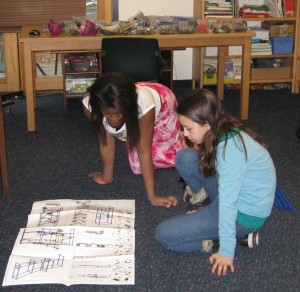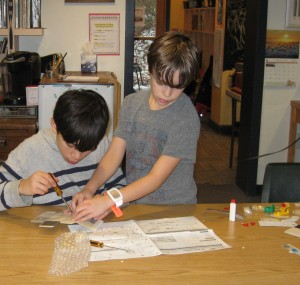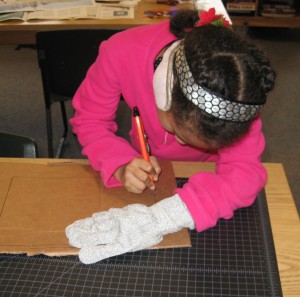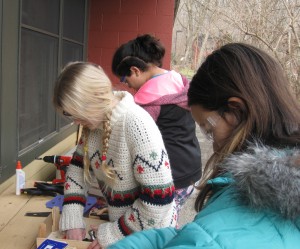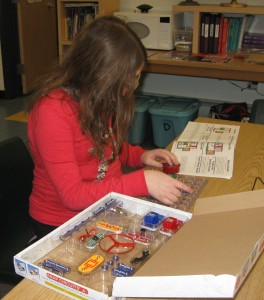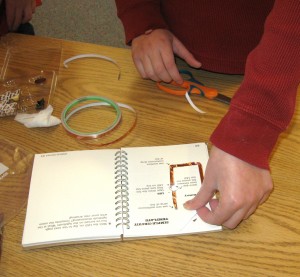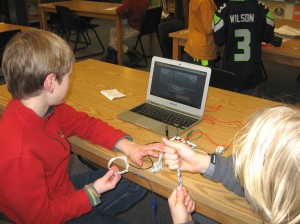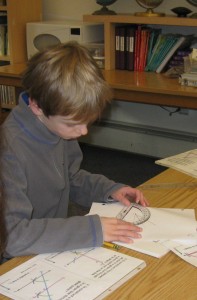We have a strong connection with our 5th/6th neighbors. Some manifestations of that connection are informal and some are intentional. Students blend for choice time activities, eating lunch, our Wednesday morning sing, some trips, special projects such as making our dulcimers, and also for math instruction. We began the year working with only our own students, but after we got to know their math skills and learning styles better, we concluded that we could provide our two classes with more learning peers and more instructional flexibility if we combined to create 5 groups that meet every afternoon for 45 minutes when they are not with their specialist.
We did that until Conference Week in November. In the weeks between then and winter break, we returned to working with just our own students. Our group explored geometry in a variety of ways, as has been described here in previous blog posts.
When we returned from Winter Break, we went back to our blended instructional groups. Because one of our major resources is the Math In Focus series (an adapted version of “Singapore Math”), we decided that it was best to create our groups based on grade level in order to work within the textbook sequence. So I am teaching two sixth grade groups, while Diane is working with another group of sixth graders, Jeri has a group of fifths, and Diane and Jeri together have the rest of the fifth graders. (We will almost certainly change around the teaching responsibilities at least once.)
What have our groups been doing?
Diane: “My sixth grade group returned to its work in The Number Devil which it does each Wednesday (and which includes one fifth grader).”

My note: That book is a fantasy in which a boy who dislikes mathematics meets with “The Number Devil” in his dreams for 12 nights. He is guided through a series of essential topics: infinite numbers, prime numbers, Fibonacci numbers, and more.
“This week we looked at permutations (combinations in which the order matters). This incorporated previous work with triangle numbers and Pascal’s triangle in this chapter as well, which the kids readily recognized. Our permutation work was largely pulled from Harold Jacob’s book, Mathematics: A Human Endeavor. Other days, we are working with Hands-On Equations. We are finished with Level I (lessons 1 – 7). Today we turned to the related word problems. I read quite a few problems aloud today, and they named the variable, set up the equations, and solved them. They are doing this in writing for homework. We’ll continue at least through Level II as they are very excited to work with negative numbers.”
Jeri: “Since my group of 5th graders returned from winter break, we have been working on bar modeling, starting with addition & subtraction, then multiplication and division, and now we have moved into mixed operation & other multi-step modeling. I have been using the Step-by-Step Bar Modeling book to present problems and follow up questions for both class and homework, and they are doing the work in their LGB (little graph books, as they named them). We have reinforced the modeling concepts through the Thinking Blocks section of the Math Playground website.
Next, we will be working on division, starting with short division, since they all have said that they do not know this operation well, if at all. We will go back into our Math in Focus texts to explore this operation, then (what I believe will be a review of) order of operations. Following that is a section of word problems that will combine all of these skills, including the modeling.
Diane: “The fifth grade group [that I teach with Jeri] at first returned to its work with bar modeling. We had turned to that for a more practical change of pace from the multiplication work they had been doing. Their computer work shows development in their understanding. They will need more in terms of drawing their own down the line. They also will need specific work around division. For the time being, though we have turned our attention to fractions, particularly to building the conceptual understanding necessary for working with adding and subtracting fractions. They are working through Key To Fractions (Book One) for homework, but in class we’ve made the fraction strip kits and are playing the games from the Marilyn Burns Fraction Set. It seems to be a good match for them. We are also pulling in some other activities (i.e. today’s fraction hunt) to work on ordering and comparing fractions. We will jump into the MIF fractions chapter as soon as they are ready for it.”
My note: That is our largest instructional group. Sometimes they split into two smaller groups and work with just one of the two teachers in order to better individualize the lesson.
Lynn: Both of my sixth grade groups have been working further in the Math in Focus chapter that deals with multiplying and dividing fractions and decimal numbers. We’re going to start division by and of decimals next week, when many of our instructional strategies described below will also apply to that topic.
________________
Next week’s blog post will contain information about our “That’s My Kind of Book!” project, which is coming to a close.

